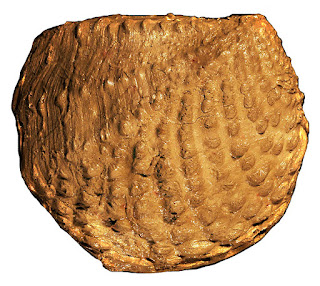Black onyx is variety of chalcedony = cryptocrystalline
quartz. In a previous post on September 14, 2018, I focused on the subject of
cryptocrystalline quartz, so please look at this post for background
information. Just use the Search box in my blog and type in the word chalcedony.
Black onyx starts out as multi-colored, banded chalcedony, which would
normally be called agate, a silica-rich material. By means of a human-induced
chemical process, the bands are eliminated, and the “stone” becomes solid
black. It is not a dyeing process. Instead, the blackening process takes places
when carbon is introduced into the “stone” via a sugar-acid reaction.
As a result, beautifully looking, pure-black “stones” are
created. They are used for making jewelry, which can be expensive.
 |
| Black onyx cuff link (15 mm diameter) |
Black onyx should not be confused with similar terms which
involve calcium-carbonate minerals and have entirely different (natural) origins.
Examples are Mexican onyx (see image below), limestone onyx, travertine, and onyx marble. These
are much softer than black onyx (silica) and also fizz when drops of 10%
hydrochloric acid are applied to them.
 |
| Mexican onyx (white and black layers) from central Arizona (USA penny 18 mm diameter) |
Also, although the extrusive volcanic rock obsidian is black (see my previous post on volcanic igneous rocks), and the variety of quartz known as “smoky quartz” is cloudy-black (see another one of my previous posts on macro-crystalline quartz), they are not the same as Black onyx.















